Left-branching language on:
[Wikipedia]
[Google]
[Amazon]
In
Examples of right-branching phrases (= head-initial phrases): ::laugh loudly - Verb phrase (VP) ::with luck - Prepositional phrase (PP) ::that it happened - Subordinator phrase (SP = subordinate clause) Examples of phrases that contain both left- and right-branching (= head-medial phrases): ::the house there - Noun phrase (NP) ::very happy with it - Adjective phrase (AP) ::only laugh loudly - Verb phrase (VP) Concerning phrases such as ''the house'' and ''the house there'', this article assumes the traditional NP analysis, meaning that the noun is deemed to be head over the determiner. On a DP-analysis (
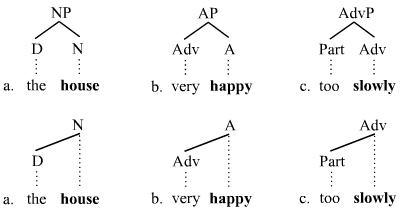 The upper row shows the constituency-based structures, and the lower row the dependency-based structures. In the constituency-based structures, left-branching is present (but not really visible) in so far as the non-head daughter is to the left of the head. In the corresponding dependency-based structures in the lower row, the left-branching is clear; the dependent appears to the left of its head, the branch extending down to the left. The following structures demonstrate right-branching:
:::
The upper row shows the constituency-based structures, and the lower row the dependency-based structures. In the constituency-based structures, left-branching is present (but not really visible) in so far as the non-head daughter is to the left of the head. In the corresponding dependency-based structures in the lower row, the left-branching is clear; the dependent appears to the left of its head, the branch extending down to the left. The following structures demonstrate right-branching:
:::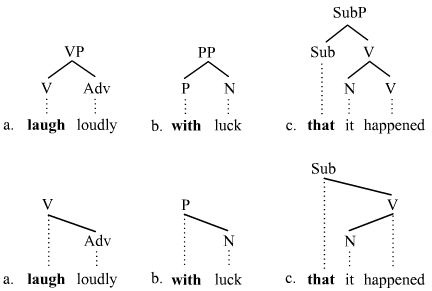 The upper row again shows the constituency-based structures, and the lower row the dependency-based structures. The constituency-based structures are right-branching insofar as the non-head daughter is to the right of the head. This right-branching is completely visible in the lower row of dependency-based structures, where the branch extends down to the right. The (c)-examples contain one instance of right-branching (the upper branch) and one instance of left-branching (the lower branch). The following trees illustrate phrases that combine both types of branching:
:::
The upper row again shows the constituency-based structures, and the lower row the dependency-based structures. The constituency-based structures are right-branching insofar as the non-head daughter is to the right of the head. This right-branching is completely visible in the lower row of dependency-based structures, where the branch extends down to the right. The (c)-examples contain one instance of right-branching (the upper branch) and one instance of left-branching (the lower branch). The following trees illustrate phrases that combine both types of branching:
::: The combination of left- and right-branching is now completely visible in both the constituency- and dependency-based trees. The head appears in a medial position, which means that the phrase combines both types of branching. Note that the (b)-trees also contain a PP phrase that is an instance of pure right-branching.
The combination of left- and right-branching is now completely visible in both the constituency- and dependency-based trees. The head appears in a medial position, which means that the phrase combines both types of branching. Note that the (b)-trees also contain a PP phrase that is an instance of pure right-branching.
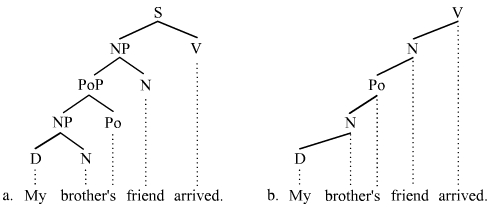 The category Po (= possessive) is used to label possessive s''. The following sentence is completely right-branching:
:::
The category Po (= possessive) is used to label possessive s''. The following sentence is completely right-branching:
:::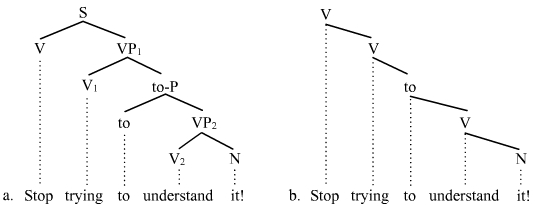 Most structures in English are, however, not completely left- or completely right-branching, but rather they combine both. The following trees illustrate what can be seen as a stereotypical combination of left- and right-branching in English:
:::
Most structures in English are, however, not completely left- or completely right-branching, but rather they combine both. The following trees illustrate what can be seen as a stereotypical combination of left- and right-branching in English:
:::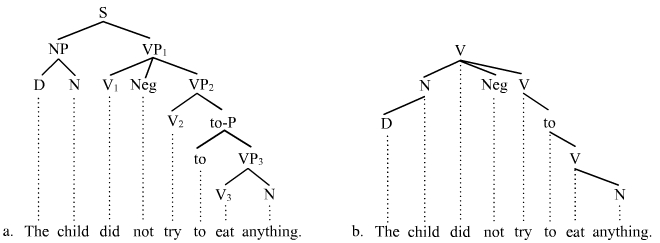 Determiners (e.g. ''the'') always and subjects (e.g. ''the child'') usually appear on left branches in English, but infinitival verbs (e.g. ''try'', ''eat'') and the verb particle ''to'' usually appear on right branches. In the big picture, right-branching structures tend to outnumber the left-branching structures in English, which means that trees usually grow down to the right.
Determiners (e.g. ''the'') always and subjects (e.g. ''the child'') usually appear on left branches in English, but infinitival verbs (e.g. ''try'', ''eat'') and the verb particle ''to'' usually appear on right branches. In the big picture, right-branching structures tend to outnumber the left-branching structures in English, which means that trees usually grow down to the right.
 This structure is both left- and right branching. It is left-branching insofar as the bar-level projection of the head (X') follows the specifier, but it is right-branching insofar as the actual head (X0) precedes the complement. Despite these conflicting traits, most standard X-bar structures (in English) are more right-branching than left-branching because specifiers tend to be less complex (i.e. fewer words) than complements.
This structure is both left- and right branching. It is left-branching insofar as the bar-level projection of the head (X') follows the specifier, but it is right-branching insofar as the actual head (X0) precedes the complement. Despite these conflicting traits, most standard X-bar structures (in English) are more right-branching than left-branching because specifiers tend to be less complex (i.e. fewer words) than complements.
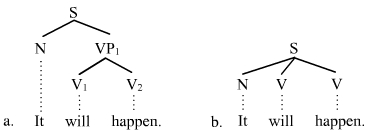 The binary branching on the left is closely associated with the structures of GB, MP, and LFG, and it is similar to what the X-bar schema assumes. The n-ary branching structure on the right is a more traditional approach to branching. One can muster arguments for both approaches. For instance, the critics of the strictly binary branching structures charge that the strict binarity is motivated more by a desire for theoretical purity than by empirical observation.
Strictly binary branching structures increase the amount of syntactic structure (number of nodes) to the upper limit of what is possible, whereas flatter n-ary branching tends to restrict the amount of structure that the theory can assume. Worth noting in this area is that the more layered the syntactic structures are, the more discontinuities can occur, which means the component of the theory that addresses discontinuities must play a greater role. Given the flatter structures associated with n-ary branching, certain phenomena (e.g. inversion and shifting) do not result in discontinuities, a fact that reduces the role that the component for discontinuities must play in the theory.
The binary branching on the left is closely associated with the structures of GB, MP, and LFG, and it is similar to what the X-bar schema assumes. The n-ary branching structure on the right is a more traditional approach to branching. One can muster arguments for both approaches. For instance, the critics of the strictly binary branching structures charge that the strict binarity is motivated more by a desire for theoretical purity than by empirical observation.
Strictly binary branching structures increase the amount of syntactic structure (number of nodes) to the upper limit of what is possible, whereas flatter n-ary branching tends to restrict the amount of structure that the theory can assume. Worth noting in this area is that the more layered the syntactic structures are, the more discontinuities can occur, which means the component of the theory that addresses discontinuities must play a greater role. Given the flatter structures associated with n-ary branching, certain phenomena (e.g. inversion and shifting) do not result in discontinuities, a fact that reduces the role that the component for discontinuities must play in the theory.
linguistics
Linguistics is the science, scientific study of human language. It is called a scientific study because it entails a comprehensive, systematic, objective, and precise analysis of all aspects of language, particularly its nature and structure ...
, branching refers to the shape of the parse trees that represent the structure of sentences. Assuming that the language is being written or transcribed from left to right
A writing system is a method of visually representing verbal communication, based on a script and a set of rules regulating its use. While both writing and speech are useful in conveying messages, writing differs in also being a reliable form ...
, parse trees that grow down and to the right are ''right-branching'', and parse trees that grow down and to the left are ''left-branching''. The direction of branching reflects the position of heads in phrase
In syntax and grammar, a phrase is a group of words or singular word acting as a grammatical unit. For instance, the English expression "the very happy squirrel" is a noun phrase which contains the adjective phrase "very happy". Phrases can consi ...
s, and in this regard, right-branching structures are ''head-initial
In linguistics, head directionality is a proposed parameter that classifies languages according to whether they are head-initial (the head of a phrase precedes its complements) or head-final (the head follows its complements). The head is the ...
'', whereas left-branching structures are ''head-final''. English has both right-branching (head-initial) and left-branching (head-final) structures, although it is more right-branching than left-branching. Some languages such as Japanese
Japanese may refer to:
* Something from or related to Japan, an island country in East Asia
* Japanese language, spoken mainly in Japan
* Japanese people, the ethnic group that identifies with Japan through ancestry or culture
** Japanese diaspor ...
and Turkish are almost fully left-branching (head-final). Some languages are mostly right-branching (head-initial).
Examples
Languages typically construct phrases with a head word (or nucleus) and zero or more ''dependents'' (modifiers). The following phrases show the phrase heads in bold. Examples of left-branching phrases (= head-final phrases): ::the house - Noun phrase (NP) ::very happy - Adjective phrase (AP) ::too slowly - Adverb phrase (AdvP)Examples of right-branching phrases (= head-initial phrases): ::laugh loudly - Verb phrase (VP) ::with luck - Prepositional phrase (PP) ::that it happened - Subordinator phrase (SP = subordinate clause) Examples of phrases that contain both left- and right-branching (= head-medial phrases): ::the house there - Noun phrase (NP) ::very happy with it - Adjective phrase (AP) ::only laugh loudly - Verb phrase (VP) Concerning phrases such as ''the house'' and ''the house there'', this article assumes the traditional NP analysis, meaning that the noun is deemed to be head over the determiner. On a DP-analysis (
determiner phrase In linguistics, a determiner phrase (DP) is a type of phrase headed by a determiner such as ''many''. Controversially, many approaches, take a phrase like ''not very many apples'' to be a DP, headed, in this case, by the determiner ''many''. This i ...
), the phrase ''the house'' would be right-branching instead of left-branching.
Tree structures
Left- and right-branching structures are illustrated with the trees that follow. Each example appears twice, once according to a constituency-based analysis associated with aphrase structure grammar
The term phrase structure grammar was originally introduced by Noam Chomsky as the term for grammar studied previously by Emil Post and Axel Thue (Post canonical systems). Some authors, however, reserve the term for more restricted grammars in th ...
and once according to a dependency-based analysis associated with a dependency grammar. The first group of trees illustrate left-branching:
::: The upper row shows the constituency-based structures, and the lower row the dependency-based structures. In the constituency-based structures, left-branching is present (but not really visible) in so far as the non-head daughter is to the left of the head. In the corresponding dependency-based structures in the lower row, the left-branching is clear; the dependent appears to the left of its head, the branch extending down to the left. The following structures demonstrate right-branching:
:::
The upper row shows the constituency-based structures, and the lower row the dependency-based structures. In the constituency-based structures, left-branching is present (but not really visible) in so far as the non-head daughter is to the left of the head. In the corresponding dependency-based structures in the lower row, the left-branching is clear; the dependent appears to the left of its head, the branch extending down to the left. The following structures demonstrate right-branching:
::: The upper row again shows the constituency-based structures, and the lower row the dependency-based structures. The constituency-based structures are right-branching insofar as the non-head daughter is to the right of the head. This right-branching is completely visible in the lower row of dependency-based structures, where the branch extends down to the right. The (c)-examples contain one instance of right-branching (the upper branch) and one instance of left-branching (the lower branch). The following trees illustrate phrases that combine both types of branching:
:::
The upper row again shows the constituency-based structures, and the lower row the dependency-based structures. The constituency-based structures are right-branching insofar as the non-head daughter is to the right of the head. This right-branching is completely visible in the lower row of dependency-based structures, where the branch extends down to the right. The (c)-examples contain one instance of right-branching (the upper branch) and one instance of left-branching (the lower branch). The following trees illustrate phrases that combine both types of branching:
::: The combination of left- and right-branching is now completely visible in both the constituency- and dependency-based trees. The head appears in a medial position, which means that the phrase combines both types of branching. Note that the (b)-trees also contain a PP phrase that is an instance of pure right-branching.
The combination of left- and right-branching is now completely visible in both the constituency- and dependency-based trees. The head appears in a medial position, which means that the phrase combines both types of branching. Note that the (b)-trees also contain a PP phrase that is an instance of pure right-branching.
Full trees
The nature of branching is most visible with full trees. The following trees have been chosen to illustrate the extent to which a structure can be entirely left- or entirely right-branching. The following sentence is completely left-branching. The constituency-based trees are on the left, and the dependency-based trees are on the right: ::: The category Po (= possessive) is used to label possessive s''. The following sentence is completely right-branching:
:::
The category Po (= possessive) is used to label possessive s''. The following sentence is completely right-branching:
::: Most structures in English are, however, not completely left- or completely right-branching, but rather they combine both. The following trees illustrate what can be seen as a stereotypical combination of left- and right-branching in English:
:::
Most structures in English are, however, not completely left- or completely right-branching, but rather they combine both. The following trees illustrate what can be seen as a stereotypical combination of left- and right-branching in English:
::: Determiners (e.g. ''the'') always and subjects (e.g. ''the child'') usually appear on left branches in English, but infinitival verbs (e.g. ''try'', ''eat'') and the verb particle ''to'' usually appear on right branches. In the big picture, right-branching structures tend to outnumber the left-branching structures in English, which means that trees usually grow down to the right.
Determiners (e.g. ''the'') always and subjects (e.g. ''the child'') usually appear on left branches in English, but infinitival verbs (e.g. ''try'', ''eat'') and the verb particle ''to'' usually appear on right branches. In the big picture, right-branching structures tend to outnumber the left-branching structures in English, which means that trees usually grow down to the right.
X-bar schema
The X-bar schema combines left- and right-branching. The standard X-bar schema has the following structure: ::: This structure is both left- and right branching. It is left-branching insofar as the bar-level projection of the head (X') follows the specifier, but it is right-branching insofar as the actual head (X0) precedes the complement. Despite these conflicting traits, most standard X-bar structures (in English) are more right-branching than left-branching because specifiers tend to be less complex (i.e. fewer words) than complements.
This structure is both left- and right branching. It is left-branching insofar as the bar-level projection of the head (X') follows the specifier, but it is right-branching insofar as the actual head (X0) precedes the complement. Despite these conflicting traits, most standard X-bar structures (in English) are more right-branching than left-branching because specifiers tend to be less complex (i.e. fewer words) than complements.
Binary vs. n-ary branching
Much work inGovernment and Binding Theory
A government is the system or group of people governing an organized community, generally a state.
In the case of its broad associative definition, government normally consists of legislature, executive, and judiciary. Government is a ...
(GB), the Minimalist Program (MP), and Lexical Functional Grammar (LFG) assumes all branching to be binary.The work of Larson (1988) and Kayne (1981, 1994) were influential in establishing strictly binary branching structures in the tradition of Chomskyan syntax. Other theories (both constituency- and dependency-based ones), e.g. early Transformational Grammar
In linguistics, transformational grammar (TG) or transformational-generative grammar (TGG) is part of the theory of generative grammar, especially of natural languages. It considers grammar to be a system of rules that generate exactly those combi ...
, Head-Driven Phrase Structure Grammar, Meaning-Text Theory, Word Grammar, etc. allow for n-ary branching. This distinction can have a profound impact on the overall nature of the theory of syntax. The two main possibilities in a phrase structure grammar are illustrated with the following trees:
::: The binary branching on the left is closely associated with the structures of GB, MP, and LFG, and it is similar to what the X-bar schema assumes. The n-ary branching structure on the right is a more traditional approach to branching. One can muster arguments for both approaches. For instance, the critics of the strictly binary branching structures charge that the strict binarity is motivated more by a desire for theoretical purity than by empirical observation.
Strictly binary branching structures increase the amount of syntactic structure (number of nodes) to the upper limit of what is possible, whereas flatter n-ary branching tends to restrict the amount of structure that the theory can assume. Worth noting in this area is that the more layered the syntactic structures are, the more discontinuities can occur, which means the component of the theory that addresses discontinuities must play a greater role. Given the flatter structures associated with n-ary branching, certain phenomena (e.g. inversion and shifting) do not result in discontinuities, a fact that reduces the role that the component for discontinuities must play in the theory.
The binary branching on the left is closely associated with the structures of GB, MP, and LFG, and it is similar to what the X-bar schema assumes. The n-ary branching structure on the right is a more traditional approach to branching. One can muster arguments for both approaches. For instance, the critics of the strictly binary branching structures charge that the strict binarity is motivated more by a desire for theoretical purity than by empirical observation.
Strictly binary branching structures increase the amount of syntactic structure (number of nodes) to the upper limit of what is possible, whereas flatter n-ary branching tends to restrict the amount of structure that the theory can assume. Worth noting in this area is that the more layered the syntactic structures are, the more discontinuities can occur, which means the component of the theory that addresses discontinuities must play a greater role. Given the flatter structures associated with n-ary branching, certain phenomena (e.g. inversion and shifting) do not result in discontinuities, a fact that reduces the role that the component for discontinuities must play in the theory.
Tendencies
As stated above, the main branching trait for a language is just a tendency and it often shows exceptions.Spanish
Spanish might refer to:
* Items from or related to Spain:
**Spaniards are a nation and ethnic group indigenous to Spain
**Spanish language, spoken in Spain and many Latin American countries
**Spanish cuisine
Other places
* Spanish, Ontario, Can ...
, for example, while overwhelmingly right-branching, puts numeral modifiers before nouns and, in certain cases, objects before verbs. Languages like English or Swedish, though regarded as being right-branching because the main verbs precede direct objects, place adjectives and numerals before their nouns. On the contrary, Northwest Caucasian languages such as Ubykh or Abkhaz are strongly left-branching but put adjectives after nouns.
Some languages, however, are exclusively left-branching or right-branching. Japanese
Japanese may refer to:
* Something from or related to Japan, an island country in East Asia
* Japanese language, spoken mainly in Japan
* Japanese people, the ethnic group that identifies with Japan through ancestry or culture
** Japanese diaspor ...
and most other languages of northeastern Asia and the Indian subcontinent
The Indian subcontinent is a list of the physiographic regions of the world, physiographical region in United Nations geoscheme for Asia#Southern Asia, Southern Asia. It is situated on the Indian Plate, projecting southwards into the Indian O ...
, as well as the Turkic languages
The Turkic languages are a language family of over 35 documented languages, spoken by the Turkic peoples of Eurasia from Eastern Europe and Southern Europe to Central Asia, East Asia, North Asia ( Siberia), and Western Asia. The Turkic l ...
, are practically a model for rigidly left-branching languages. The Mon–Khmer
The Austroasiatic languages , , are a large language family in Mainland Southeast Asia and South Asia. These languages are scattered throughout parts of Thailand, Laos, India, Myanmar, Malaysia, Bangladesh, Nepal, and southern China and are th ...
and Austronesian languages of southeast Asia and many African languages
The languages of Africa are divided into several major language families:
* Niger–Congo or perhaps Atlantic–Congo languages (includes Bantu and non-Bantu, and possibly Mande and others) are spoken in West, Central, Southeast and Souther ...
come close to rigidly right-branching, with numerals as well as adjectives following their nouns and with degree words like ''very'', ''too'', ''extremely'', and ''quite'' following the adjectives they modify.
See also
* Catena * Complement (linguistics) * Dependency grammar * Head * Head-directionality parameter *Phrase structure grammar
The term phrase structure grammar was originally introduced by Noam Chomsky as the term for grammar studied previously by Emil Post and Axel Thue (Post canonical systems). Some authors, however, reserve the term for more restricted grammars in th ...
* Specifier
*Word order
In linguistics, word order (also known as linear order) is the order of the syntactic constituents of a language. Word order typology studies it from a cross-linguistic perspective, and examines how different languages employ different orders. C ...
*X-bar theory
In linguistics, X-bar theory is a model of phrase-structure grammar and a theory of syntactic category formation that was first proposed by Noam Chomsky in 1970Chomsky, Noam (1970). Remarks on Nominalization. In: R. Jacobs and P. Rosenbaum (eds.) ...
Notes
References
*Berg, T. 2009. Structure in language: A dynamic perspective. New York: Routledge. *Chomsky, N. 1957. ''Syntactic Structures''. The Hague/Paris: Mouton. *Chomsky, N. 1970. Remarks on nominalization. In R. Jacobs and P. Rosenbaum (eds.), ''Readings in English Transformational Grammar'', 184–221. Waltham: Ginn. *Comrie, B 1989. ''Language universals and linguistic typology : syntax and morphology'', 2nd edition. Oxford: Basil Blackwell. *Fowler, R. 1971. An introduction to transformational syntax. London: Routledge. *Haspelmath, M., M. Dryer, D. Gil, and B. Comrie (eds.) 2005. ''The World Atlas of Language Structures''. Oxford: Oxford University Press. *Jackendoff, R. 1977. X-bar-syntax: A study of phrase structure. ''Linguistic Inquiry'' Monograph 2. Cambridge, MA: MIT Press. *Kayne, R. 1981. Unambiguous Paths. In R. May and J. Koster (eds.), ''Levels of syntactic representation'', 143–183. Dordrecht: Kluwer. *Kayne, R. 1994. The antisymmetry of syntax. ''Linguistic Inquiry'' Monograph Twenty-Five. MIT Press. *Kayne, R. 2010. Why are there no directionality parameters? In ''WCCFL'' XXVIII. Available on http://ling.auf.net/lingBuzz/001100. *Larson, R. 1988. On the double object construction. ''Linguistic Inquiry'' 19, 335–392. *Payne, T. 2006. Exploring language structure: A student's guide. Cambridge, UK: Cambridge University Press. *van Riemsdijk, H. and E. Williams. 1986. Introduction to the theory of grammar. Cambridge, MA: The MIT Press. *Tesnière, Lucien 1959. ''Éleménts de syntaxe structurale''. Paris: Klincksieck. {{refend Grammar Linguistic typology Word order